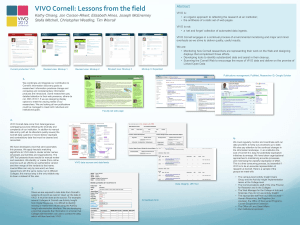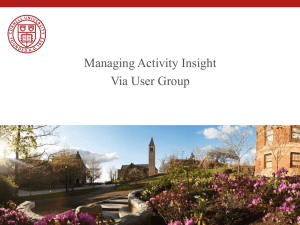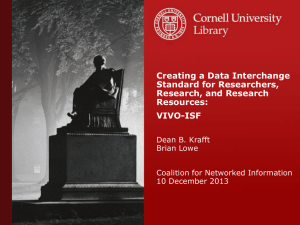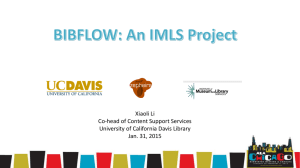Presentation
advertisement
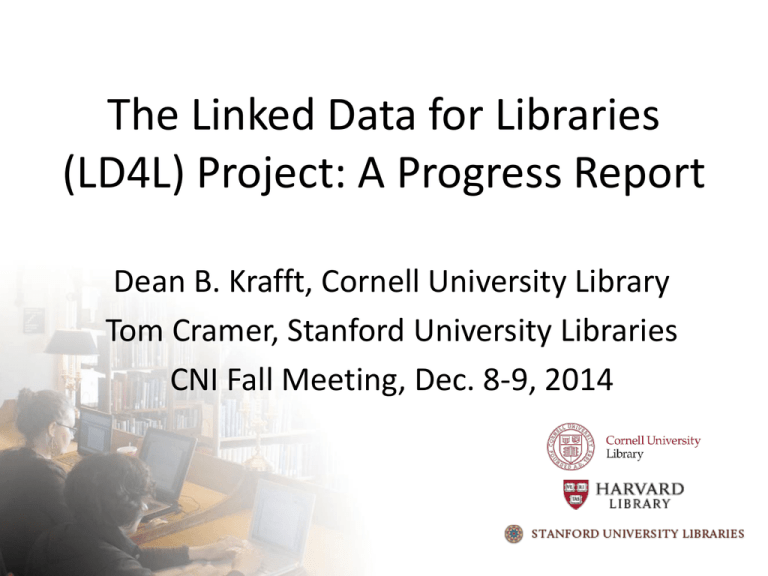
The Linked Data for Libraries (LD4L) Project: A Progress Report Dean B. Krafft, Cornell University Library Tom Cramer, Stanford University Libraries CNI Fall Meeting, Dec. 8-9, 2014 Linked Data for Libraries (LD4L) • On December 5, 2013, the Andrew W. Mellon Foundation made a two-year $999K grant to Cornell, Harvard, and Stanford starting Jan ‘14 • Partners will work together to develop an ontology and linked data sources that provide relationships, metadata, and broad context for Scholarly Information Resources • Leverages existing work by both the VIVO project and the Hydra Partnership Vision: Create a LOD standard to exchange all that libraries know about their resources Courtesy National Gallery of Art, Washington “The goal is to create a Scholarly Resource Semantic Information Store model that works both within individual institutions and through a coordinated, extensible network of Linked Open Data to capture the intellectual value that librarians and other domain experts add to information resources when they describe, annotate, organize, select, and use those resources, together with the social value evident from patterns of usage.” What is Linked Open Data? • Data – Structured information, not just documents and text – A common, simple format • Open – Available, visible, mine-able – Anyone can post, consume, and reuse • Linked – Directly by reference – Indirectly via common references and inference RDF “triples” Why Linked Data • It is a flexible and extensible framework that libraries can use to describe, organize, and relate scholars, scholarship, and the scholarly context • There are a wide range of tools, systems, ontologies, and vocabularies already available • It is a growing ecosystem of developers, standards, and sources of relevant Linked Open Data Linking Open Data cloud diagram 2014, by Max Schmachtenberg, Christian Bizer, Anja Jentzsch and Richard Cyganiak. http://lod-cloud.net/" What is VIVO? • Software: An open-source semantic-web-based researcher and research discovery tool • Data: Institution-wide, publicly-visible information about research and researchers • Standards: A standard ontology (VIVO data) that interconnects researchers, communities, and campuses using Linked Open Data • Community: An open community with strong national and international participation VIVO is a Semantic Web application • Provides data readable by machines, not just text for humans • Provides self-describing data via shared ontologies – Defined types – Defined relationships • Provides search & query augmented by relationships • Does simple reasoning to categorize and find associations – Teaching faculty = any faculty member teaching a course – All researchers involved with any gene associated with breast cancer (through research project, publication, etc.) VIVO connects scientists and scholars with and through their research and scholarship How LD4L builds on VIVO • LD4L brings the relationship and identifier-based architecture of VIVO to mainstream library use cases and applications • The LD4L ontology will draw on VIVO-ISF ontology design patterns (among others) • Vitro as a semantic web browser will play a role in LD4L infrastructure along with more specialized, purposebuilt tools • The multi-institution LD4L demonstration search will be an adaptation of VIVOsearch.org • LD4L will link to existing VIVO data in addition to Harvard Faculty Finder and Stanford CAP data BIBFRAME • The Library of Congress (LoC) has developed the BIBFRAME ontology as an (eventual) replacement for MARC, the current cataloging standard for library resources • Both LoC and Zepheira, a contractor, have developed converters that produce BIBFRAME RDF from MARC XML http://bibframe.org/ Why BIBFRAME? • The Library of Congress BIBFRAME initiative “provides a foundation for the future of bibliographic description, both on the web, and in the broader networked world.” • We are academic libraries • We are building from existing library catalog data in MARC and want to mainstream the use of identifiers and linked data in our library workflows bibframe.org BIBFRAME basic entities and relationships http://bibframe.org/vocab-model/ Adding identifiers • Translating MARC records into RDF will not in and of itself make useful linked data • Identifiers are essential – Local identifiers for statements made by an institution, both local authority information and annotation – Global identifiers for people, organizations, and places where they can be reliably determined • OCLC Work URIs for shared works across institutions • VIAF, ORCID for people • Evaluating Dbpedia for place linkages Goal: from strings to things • • • • • • • People Organizations Places Subjects Events Works Datasets Image: designyoutrust.com Leveraging OCLC work identifiers • OCLC WorldCat functions as a union catalog of bibliographic identifiers shared across institutions • Goal is to reference common OCLC Work URIs in bibliographic resources from Cornell, Harvard, and Stanford to support common search discovery and interlinking – Harvard: 82% of 13.6 million bib records can be matched to OCLC Work identifiers – Stanford and Cornell have ~2.6 million records in common out of ~5.8 million in each collection – Annotations and usage information can then be compared across 3 institutions – If it can work for 3, it can work for many Likely components of the LD4L ontology • Library resources: BIBFRAME • Additional bibliographic types and partonomy relationships: FaBiO • People/Organizations: VIVO-ISF (includes FOAF) • Annotations: OpenAnnotation • Provenance: PAV • Virtual Collections and Structured Relationships: OAI-ORE • Concepts: SKOS (or vocabularies such as Getty with stable URIs) • Many identifiers: VIAF, ORCID, ISNI, OCLC Works Snapshot of LD4L ontology discussion For Illustration - NOT FINAL (And probably changing to reflect new bf:Person definition in 2015) Ontology Challenges • We need to think about identifying people, and their relationships to other entities • There are already identifiers for people and works, which need to be connected • There are hard choices around the edges to be made, such as a single person with multiple identities, but that shouldn't stop progress being made for the 99.999% Entity Reconciliation • Locally critical to link information across library system silos • Essential to link across the three partners to support discovery, annotation, virtual collections: works, people, places, subjects, etc. • Linking to web of LOD surfaces new relationships and networks • Library role: expose our own unique entities and connect them to the rest of the world The more we can link, the more we can discover The More We Can Link: Loosely Connected Researchers Strongly Connected Researchers How will LD4L make these connections? • By using ontologies commonly found in linked data • By connecting with Cornell VIVO/Stanford CAP/Harvard Profiles information • By using persistent, stable local identifiers (URIs) • By linking stable local identifiers to global identifiers (ORCID, VIAF, ISNI) • By supporting annotations with provenance • By linking to external sources of networked relationships: Dbpedia, IMDB, OCLC LD4L Data Sources Person Data • VIVO • ORCID • ISNI • VIAF Bibliographic Data • MARC • MODS • EAD Usage Data • Circulation • Citation • Curation • Exhibits • Research Guides • Syllabi • Tags Stories as the Basis of Use Cases As a ______, I want to _______, so that I can <realize this benefit>. Potential Demonstrations: A. Demo 1 B. Demo 2 C. Demo 3 Data Sources Needed: Ontology Requirements: Engineering Work: 42 Raw Use Cases 12 Refined Use Cases in 6 clusters… 42 Raw Use Cases 12 Refined Use Cases in 6 clusters… LD4L Use Case Clusters 1. Bibliographic + curation data 2. Bibliographic + person data 3. Leveraging external data including authorities 4. Leveraging the deeper graph (via queries or patterns) 5. Leveraging usage data 6. Three-site services, e.g. cross-site search Sample Refined Use Cases 1.1: Build a virtual collection As a faculty member or librarian, I want to create a virtual collection or exhibit from multiple collections, so that I can share a focused collection with a <class, set of researchers, set of students in a disciplinary area>. 1.2: Tag scholarly information resources to support reuse As a librarian, I would like to be able to tag scholarly information resources into curated lists, so that I can feed these these lists into subject guides, course reserves, or reference collections. https://wiki.duraspace.org/display/ld4l/LD4L+Use+Cases Engineering Work Phase 1: Annotations 1.1 Build a Virtual Collection 1.2 Tag Scholarly Resources to Support Reuse Phase 2: Authorities 2.1 Discover Works via People and their Relationships 3.1 Discover Works via Locations and their Relationships 3.2 Discover Works via Concepts and their Relationships Phase 3: Linked Open Data 4.* Leverage the Deeper Graph 5.* Leverage Usage Data for <Research, Collection Building> 6.1 Cross-Institution Discovery Engineering Work Phase 1: Annotations 1.1 Build a Virtual Collection 1.2 Tag Scholarly Resources to Support Reuse Phase 2: Authorities 2.1 Discover Works via People and their Relationships 3.1 Discover Works via Locations and their Relationships 3.2 Discover Works via Concepts and their Relationships Phase 3: Linked Open Data 4.* Leverage the Deeper Graph 5.* Leverage Usage Data 6.1 Cross-Institution Discovery http://projecthydra.org What Is Hydra? • A robust repository fronted by feature-rich, tailored applications and workflows (“heads”) ➭ One body, many heads • Collaboratively built “solution bundles” that can be adapted and modified to suit local needs. • A community of developers and adopters extending and enhancing the core ➭ If you want to go fast, go alone. If you want to go far, go together. Technical Framework - Components • Fedora provides a durable repository layer to support object management and persistence • Solr, provides fast access to indexed information • Blacklight, a Ruby on Rails plugin that sits atop solr and provides faceted search & tailored views on objects • Hydra-Head, a Ruby on Rails plugin that provides create, update and delete actions against Fedora objects How LD4L builds on Hydra • We will augment the ActiveTriples gem to mimic ActiveFedora • We will write code to store Open Annotations (OA) linked data in Fedora 4, natively • We will use Blacklight as a UI for making/viewing annotations, and for searching data indexed from LD4L triple stores • We will leverage the Questioning Authority Gem for Use Case 3.4: LOD-based Data Entry • Provides model for access to library data • Includes access to ShelfRank/StackScore for Harvard Library resources • Provides concrete example for creating an ontology for usage • Source data for Harvard LD4L instance Assembling the Data 3. Bibliographic SDR 2. Authorities 1. Annotations CAP GeoBL MARC (Auth) Agents Places Topics OCLC HighWire MARC (Bib) Biblio Person Organization Place Subject Classification Work Instance Holding Comment Tag Review Annos Graph Search Applicatʼn 4. Linked Open Data Annotator LD4L working assumptions • Trying to do conversion and relation work at scale--with full sets of enterprise data – Harvard: 13.6 million bibliographic records – Stanford and Cornell: roughly 8 million bib records in each collection • Trying to understand the pipeline / workflows that might be needed for this • Looking to build useful, value-added services on top of the assembled triples Challenges • Perfection as the enemy of the good (e.g., in ontologies and reconciliation) • Minting vs. finding identifiers • Wider issues of entity reconciliation -- when do we mean sameAs vs. seeAlso? • Scale • Leveraging technologies developed for other purposes (e.g., LibGuides, DMS, CAP) • Thinking outside the bibliographic box Enhancing discovery and understanding with fully reconciled linked data Ideally library descriptions of our information resources will: • Refer to identified works, people, organizations, places, events, and subject headings • Be discoverable in concert with other explicit and implicit library metadata of all types • Join with local personal and organizational profile data to form a coherent, richer local authority picture • Interoperate across libraries • Interoperate with any other linked data via common, global identifiers and shared ontologies Current state of the LD4L project Courtesy National Gallery of Art, Washington Project timeline 2014 • Jan-June 2014: Initial ontology design; identify data sources; identify external vocabularies; begin LD4L and Hydra ActiveTriples development • July-Dec 2014: Complete initial ontology; complete initial ActiveTriples development; pilot initial data ingests into Vitro-based LD4L instance at Cornell Workshop – February 2015 • Hold a two-day by invitation workshop for 25 attendees from 10-12 interested library, archive, and cultural memory institutions • Demonstrate initial prototypes of LD4L and ontology • Obtain feedback on initial ontology design • Obtain feedback on overall design and approach • Make connections to support participants in piloting this approach at their institutions • Understand how institutions see this approach fitting in with their own multi-institutional collaborations and existing cross-institutional efforts such as the Digital Public Library of America, VIVO, and SHARE Project timeline Jan-June 2015 • Pilot LD4L instances at Harvard and Stanford • Populate Cornell LD4L instance from multiple data sources including MARC catalog records, EAD finding aids, VIVO data, CuLLR, and local digital collections • Develop a test instance of the LD4L Search application harvesting RDF across the three partner institutions • Integrate LD4L with ActiveTriples Project timeline July-Dec 2015 • Implement fully functional LD4L instances at Cornell, Harvard, and Stanford • Public release of open source LD4L code and ontology • Public release of open source ActiveTriples Hydra Component • Create public demonstration of LD4L Searchbased discovery and access system across the three LD4L instances LD4L Partnership • Cornell, Harvard, and Stanford brought together by common interest in Linked Data • Researchers, developers, and production metadata/cataloging all involved • Will seek to expand LD4L community at workshop in February 2015 • Significant overlap between LD4L efforts and work of both VIVO and Hydra communities: code will go to those repositories LD4L Team – June 2014 Project Outcomes • Open source extensible LD4L ontology compatible with VIVO ontology, BIBFRAME, and other existing library LOD efforts • Open source LD4L semantic editing, display, and discovery system • Project Hydra compatible interface to LD4L, using ActiveTriples to support Blacklight search across multiple LD4L instances Libraries must evolve and collaborate to meet the needs of tomorrow’s scholars and researchers J.W. Audubon - Ivory-billed Woodpecker Questions?

